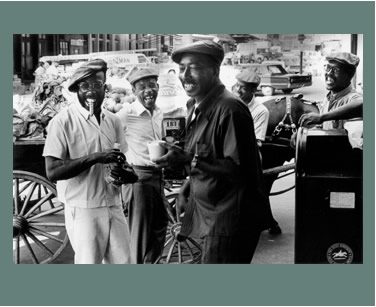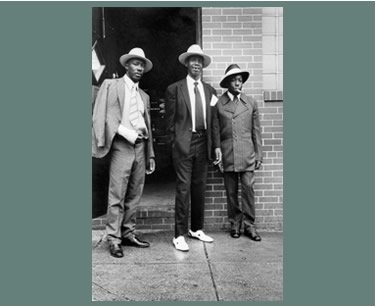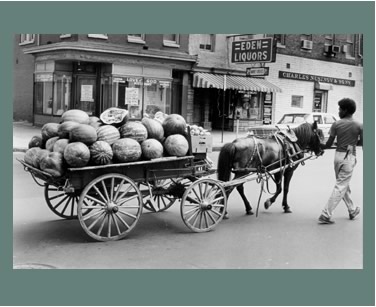Photo caption:
A morning gathering of Baltimore Arabbers at Old Camden Street Market, where they purchase produce. Left to right: Benjamin 'Winfield' Meekins, Raymond Franklin, 'Peter Rabbit,' Gilbert Hall, Sr., and 'Skeetez Mo.' Baltimore, MD, June 1971.

Photo caption (right):
Baltimore Arabbers, June, 'Monk,' and
'Winfield' dressed for the funeral of Raymond Owens.
Baltimore, MD, June 1972.
Baltimore Arabbers, June, 'Monk,' and
'Winfield' dressed for the funeral of Raymond Owens.
Baltimore, MD, June 1972.

Photo caption (below):
East Baltimore, MD, June 1971.

An era of horse and wagon commerce in the city of Baltimore dates back more than 200 years (Bullock). Many immobile and elderly citizens have grown to depend on the arabbers to bring them items that they might not have been able to get due to their situations. This has allowed the arabbers to become a part of Baltimore history that is slowly vanishing due to urban renewal and increasing effects of government regulation. For those who may not be familiar with this group of entrepreneurs, I included this video clip “We are Arabbers” courtesy of “You Tube” that helps you to gain a better understanding of how arabbers began in the city of Baltimore.
Arabbing began in the early 1800s, when access to ships and stables made it an easy form of entrepreneurship (Wikipedia). The trade is seen by both black and white Baltimoreans as more deeply rooted in black culture and history. Arabbers follow a commercial tradition common to city life in early history where using a horse and a wagon for the delivery and removal of household goods provided occasional money-making opportunities. The popular business opportunity was selling fruit, produce, and other food items door-to-door up and down every street and alley to earn a day’s pay to survive. A friendly camaraderie binds the arabbers together, and they are often seen joking and laughing among themselves. Children of arabbers grow up in the street world of horses, harnesses and carts, learning how to care for the animals, repair broken bridles, deal with wholesalers from whom they buy fresh produce, and master the art of street salesmanship.
Author Roland Freeman states that “some observers have attributed the present attitude toward street vendors to the residue of the Great Depression, which saw unprecedented numbers of working-age men take to the streets as vendors, selling whatever was at hand as a job of last resort (5). In cities like Baltimore, where marketplaces tended to be more numerous, less permanent, and unrestricted by exclusive contracts between sellers and buyers, portable produce businesses represented a point of entry into the commercial world, and one that required a fairly modest investment of time and money. Arabbers are entrepreneurs that start and end their days just like other rooming salesmen do. They load up the products to sell in the morning and return in the evening with what’s left from the days supply. These two photos courtesy of “Photoshelter.com” are images of arabbers and their daily routine through the small streets of Baltimore as part of a day’s work.


Actions taken by the City started to make earning a profit a daily struggle for the arabbers. According to Gunther, “the decline of arabbing began in 1966 when the City made it virtually impossible to construct any new stables within its limits” (8). In addition, “government urban renewal projects closed some of the remaining stables as well as the City's wholesale produce market in the Inner Harbor, which made it much more difficult for arabbers to conveniently obtain their stock” (Gunther 8). The arabbers seemed to view themselves as being pushed out of the city and into a state of non-existence. Their numbers are dwindling, but street vendors who call themselves arabbers still provide Baltimore with a type of commerce that is long forgotten in most cities.
The steady increase in Baltimore’s population created a problem for the arabbers and city residents, and with local city officials. It also started the beginning of many troubles that continue today. With more people living in the city neighborhoods, city officials became increasingly stricter in relations to health and safety issues of the arabbers horses and the city residents. Another problem that could not be avoided was the battle over space taken for urban development that is shrinking the choices of available areas large enough to house all the arabbers horses. Author Marty Katz states that “The neighborhood where some arabbers stable their horses, Sandtown-Winchester, is undergoing a major development project that will include block after block of new town houses. In addition, in the last two years an animal rights group, the Maryland Horse Protection Coalition, has tried to shut the arabbers down, saying that the horses are mistreated” (1). The coalition along with the support of People for the Ethical Treatment of Animals (PETA) and the Humane Society of the United States are attempting to convince the city to eliminate arabbing or at least protect the well-being of the horses (Katz 2). Organizations are trying to drive the arabbers horses off the city streets, forcing their stables to the counties, a move that would result in their economic demise.
Contributing to the arabbers economic demise was the condemning of the horse stable on Retreat Street where they housed over fifty horses used by the arabbers. City officials condemned the building citing structural damage and unsafe conditions as the major reasons for their actions. Arabbers scramble to load their horses into trailers bound for a makeshift stable at Pimlico Race Course. This video clip courtesy of “YouTube” gives you a glimpse of what took place at the Retreat Street stables.
Photo caption (below): Baltimore's Deputy Commissioner Reginald Scriber
Photo courtesy of: http://static.baltimorehousing.org/pdf/org15.pdf

I got an opportunity to interview Baltimore's Deputy Commissioner Reginald Scriber when I found out that he was the person in charge of dealing with the arabbers issues. In a recent interview with Mr. Scriber, he explained that the start of the arabbers troubles began when the city officials moved the arabbers into a city owned building on Retreat Street, rent free, so that they could continue arabbing on the city streets of Baltimore (Scriber). The problem was that the city officials were unaware of the shape the building was in beforehand. There move was the result of a lack of available space in Baltimore which continues to be an issue. Blame has been passed back and fourth between city officials and the arabbers as to who is mostly responsible for the troubles the entrepreneurs have been facing and for the cause of the fading tradition in Baltimore.
The Retreat Street stables was eventually condemned due to poor conditions and not having operating utilities and running water to properly care for the animals that the arabbers were using. Mr. Scriber stated that "the arabbers have to step up and be more responsible as businessmen to show that they are worthy of receiving any help from the city" (Scriber). We discussed the plans the city has in the works for the arabbers to become a part of the tourist attraction being put together at the B & O Railroad museum and the brochure that they are in the process of developing that will include a section focusing on the history of Baltimore's arabbers. The Deputy Commissioner also made me aware that Baltimore's economic shortfalls has severely limited what options or help that can be offered to the arabbers. Finding money in the City's budget to build a suitable stable for the arabbers and their animals or using the money to help with Baltimore's urban renewal projects and the struggling citizens of Baltimore is what city officials will have to determine in the best interest of the city.
With the assistance of city officials and the B & O Railroad Museum, the arabbers were moved to a temporary home at 650 South Fulton Avenue in South Baltimore. This location has been their home for the past two years since the Retreat Street stables were closed. According to Deputy Commissioner Scriber, the move was expensive for the city because it cost about $10,000 a month to rent the tents that were used to house the animals (Scriber). In addition, he mentioned that city officials began to have meetings about the mounting costs for the temporary home and what future plans the arabbers and city officials could agree upon that would continue the arabbers existance in Baltimore (Scriber). One major issue that haulted things moving forward was the inability of the arabbers to produce a business plan that would reassure the city that they would be making a sound investment in helping the arabbers to get a new building to house their animals. While things were at a stand still, the arabbers had another major setback that makes their future even more doubtful.
On November 10, 2009 Baltimore officials confiscated 19 horses owned by the arabbers because they were living in unsafe and inhumane conditions in tents under the Monroe Street bridge. These actions was the latest move in a continuing controversy between city officials and arabbers over the care of the horses and their use in Baltimore. City officials had talked about building a permanent stable on the Fulton Avenue site, but city officials changed their minds because "inspections had shown the horses were not being kept properly" (Scriber). These two links to videos provide a detailed storyline to what took place when the horses were confiscated.
http://www.youtube.com/watch?v=hLw8UnSjt7A
http://wjz.com/video/?id=63024@wjz.dayport.com
Arabbing, one of the last colorful and personal traditions in Baltimore, seems to be on the way out. A kind of small business that helped many African American men survive poverty - a business open to the person without capital - will have died. And people who have known nothing else for the better part of their lives, some who are too old to learn anything else, will be faced with finding new jobs or joining the growing ranks of the public-assisted unemployed. In conclusion, my hope is that city officials and arabbers sincerely come together to develop a beneficial plan that will allow the long lasting tradition of Baltimore to continue throughout the streets of Baltimore City.
Works Citied
Bullock, Scott. Baltimore: No Harbor for Entrepreneurs. Taxi-Library.org. 1 Dec. 2009.
Freeman, Roland. The Arabbers of Baltimore. Centreville: Tidewater, 1989.
Gunther, Katie. Fight Over Arabs' Stables Goes On, But Now Opponents Are Going To Court.
The Sun. Baltimore 22 July 1984. 1 Dec. 2009.
Katz, Marty. For Horse-Drawn Carts, Hurdles in Baltimore. NY Times 12 Nov. 1995. 1 Dec.
2009.
Scriber, Reginald. Personal Interview. 3 Nov. 2009.
http://en.wikipedia.org/wiki/Arabber
http://www.photoshelter.com/c/billcrandall/gallery/Baltimore/G0000PO.iW6pzmcQ/
http://tgcd.org/exh_set.cfm?eid=5
Freeman, Roland. The Arabbers of Baltimore. Centreville: Tidewater, 1989.
Gunther, Katie. Fight Over Arabs' Stables Goes On, But Now Opponents Are Going To Court.
The Sun. Baltimore 22 July 1984. 1 Dec. 2009.
Katz, Marty. For Horse-Drawn Carts, Hurdles in Baltimore. NY Times 12 Nov. 1995. 1 Dec.
2009.
Scriber, Reginald. Personal Interview. 3 Nov. 2009.
http://en.wikipedia.org/wiki/Arabber
http://www.photoshelter.com/c/billcrandall/gallery/Baltimore/G0000PO.iW6pzmcQ/
http://tgcd.org/exh_set.cfm?eid=5
No comments:
Post a Comment